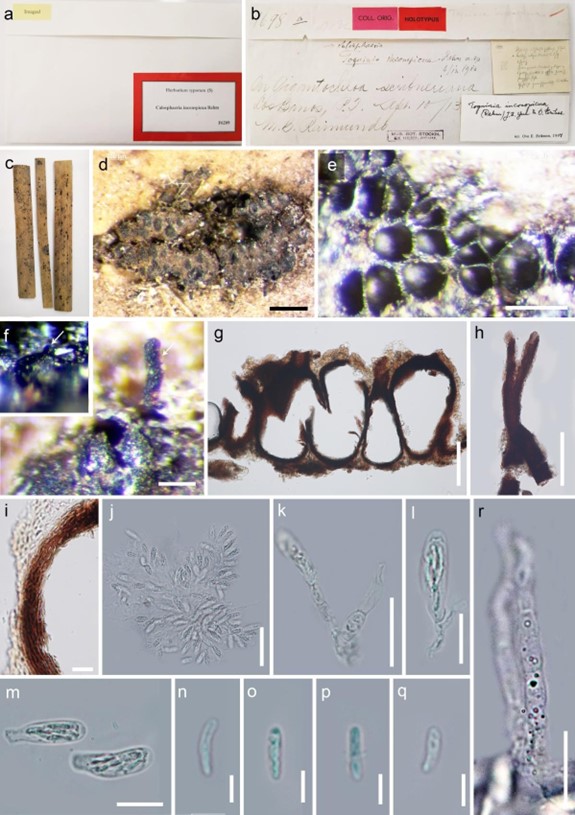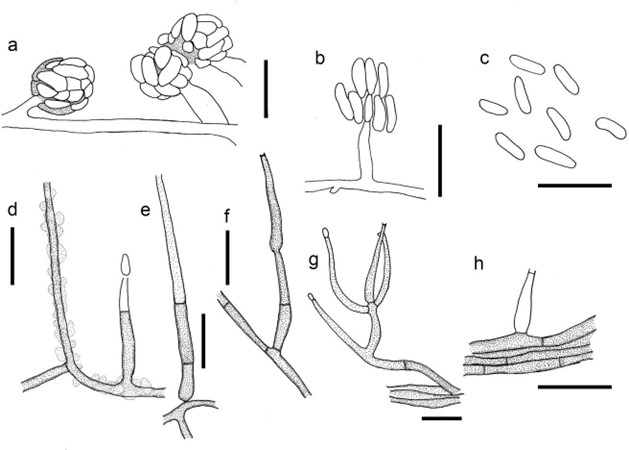Phaeoacremonium W. Gams, Crous & M.J. Wingf., Mycologia 88(5): 789 (1996)
Mycobank number: MB 27679; Index Fungorum number: IF 27679; Facesoffungi number: FoF 02140; 63 morphological species (Species Fungorum 2020), 62 species with sequence data.
Type species – Phaeoacremonium parasiticum (Ajello, Georg & C.J.K. Wang) W. Gams, Crous & M.J. Wingf.
Notes – Phaeoacremonium was introduced by Crous et al. (1996) for five new species with P. parasiticum as the type species. They mentioned this genus is similar to Phialophora and Acremonium. Mostert et al. (2003) confirmed Phaeoacremonium as the asexual morph of Togninia based on their morphological comparison, sexual compatibility and DNA phylogeny. Togninia was introduced by Berlese (1990) with Togninia minima as the type species. Togninia has previously classified in Calosphaeriaceae, Calosphaeriales (Berlese 1900, Barr 1985, Mostert et al. 2003). Réblová et al. (2004) erected Togniniaceae in Diaporthales to accommodate Phaeoacremonium and Togninia based on phylogenetic analysis of LSU and SSU sequence data. Subsequently, Mostert et al. (2006) added several species to both Phaeoacremonium and Togninia, coupled with the generic descriptions. Currently, 67 epithets of Phaeoacremonium are listed in Index Fungorum (2020). Among them, Phaeoacremonium chlamydosporum was transferred to Phaeomoniella (Gams & Crous 2000). Phaeoacremonium aleophilum, P. mortoniae and P. novae-zealandiae were synonymized under P. minimum, P. fraxinopennsylvanicum and P. leptorrhynchum, respectively (Réblova 2011, Gramaje et al. 2015). To date, 63 species are accepted in this genus, of which P. aquaticum only have ITS gene sequence available. For P. inconspicuum, no ex-type culture or DNA exists (Gramaje et al. 2015). The remaining 62 species have been confirmed with molecular data.
Herewith, we illustrated Phaeoacremonium inconspicuum (S F6209, holotype), an old collection without any available ex-type culture or DNA sequence data. The previous description was provided with hand-drawn illustrations (Eriksson & Yue 1990). But the morphology of this species are poorly described. Gramaje et al. (2015) treated it as a new combined species of P. inconspicuum based on the original description derived from Eriksson & Yue (1990). Here we refine it to clarify its classification with the microscopic character of ascomata, asci and ascospores and make sure that this species belonging to this genus.

Figure 247 – Phaeoacremonium inconspicuum (Material examined – PHILIPPINES, Luzon, Laguna Province, Los Baños, on Gigantochloa schrebneriana, 10 September 1913, M.B. Raimundo, S-F6209, holotype). a, b Envelope with original information. c-e Aggregated perithecia on bamboo column. f, h Perithecial necks (arrows). g Vertical section of ascomata. i Peridium. j-l Ascogenous hyphae with asci attached. m Asci containing ascospores. n-q Ascospores. r Paraphyses. Scale Bars: d, e = 200 µm, f = 1 mm, g = 100 µm, h = 150 µm, i, k = 25 µm, j = 50 µm, l, m, r = 15 µm, n-q = 5 µm.

Figure 248 – Phaeoacremonium krajdenii (CBS 109479) (reproduced from Mostert et al. 2006) (a, f, h), P. aleophilum (CBS 246.91) (b), P. austroafricanum (CBS 112949) (c), P. parasiticum (CBS 860.73) (d, e) P. inflatipes (CBS 391.71) (g). a, b Conidiophores. c Conidia. d Mycelium with mucus and phialides. e-h Phialides. Scale bars: a-h = 10 µm.
Species
